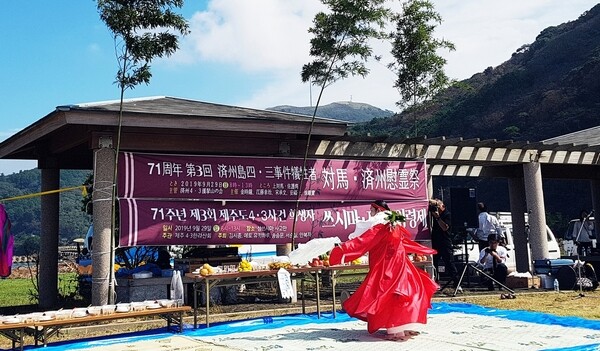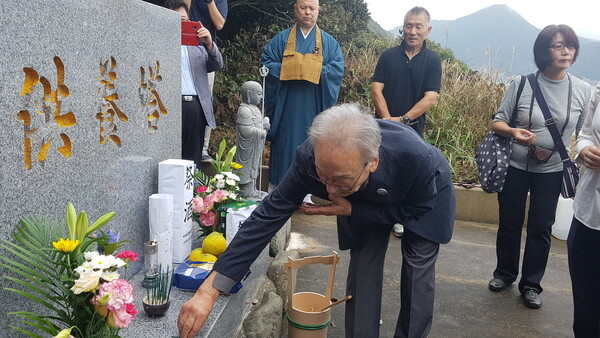hankyoreh
Links to other country sites 다른 나라 사이트 링크
Ceremony for Jeju Massacre victims held on Japan’s Tsushima Island

A ceremony was held on the Japanese island of Tsushima to remember victims of the Jeju Massacre (also known as the Jeju April 3 Uprising and Massacre).
Held on Sept. 29, the 3rd Tsushima-Jeju Memorial Ceremony for Victims of Jeju April 3 was sponsored by the April 3 Hallasan Association, a Japanese group focused on the Jeju April 3 issue, and organized by officials involved in Jeju April 3-related activities in Japan and Jeju, including Zainichi Korean poet Kim Si-jong.
Beginning at 8 am that day at Sago Bay in Kamitsushima, the ceremony included the paying of respects at a memorial tower erected on a beach where hundreds of bodies had floated over during the events of Jeju April 3 and the Korean War, followed by a memorial rite at Sea Land in nearby Minatohama, led by Jeju Keun-gut (Great Rite) Preservation Society Chairperson Seo Sun-sil and other society shamans.
Sharing his reaction while standing before the tower at the ceremony that day, Kim Si-jong explained, “Tsushima collected the bodies of hundreds of lost and massacred people who floated over from the Korean Peninsula around the time of Jeju April 3 and 1950, and they even built a memorial tower to soothe their souls.
“Standing in front of the tower and hearing the sound of the Tsushima waves, which seem to come from the spirits themselves, I feel as though the victims are bringing us together,” he said.

Kim also said, “The massacres of people in preventive custody during Jeju April 3 and the Korean War and the national tragedy of the Korean Peninsula’s division into South and North trace back to the colonial rule by imperial Japan.”
“This memorial tower will serve to perpetuate the remembered forever as a benevolent edifice soothing not only the spirits of the victims, but the hearts of the Korean and Japanese people,” he continued.
“As an event connecting Tsushima and Jeju, the Jeju April 3 memorial festival is destined to become something that the South Korean and Japanese publics do together across their borders,” said Isamu Nagata, an adviser with the April 3 Hallasan Association, which organized the ceremony.
The gut (traditional exorcism) ceremony held at Sea Land in Minatohama included a “yowangjil” rite to comfort the victims by raising the drowned spirits upon onto land.
The memorial tower at Sago Bay was erected at a site where the drifting bodies of Koreans that arrived on the island around 1950 were buried in May 2007, in accordance with the will of Hikaru Eto – father of Tsushima resident Yukiharu Eto, 62 – who joined other residents in collecting the bodies and comforting their spirits at the time.
The tower bears a message reading, “The bodies of people of all ages, men and women, who were killed in the horrors of the Korean War washed up here, crossing the harsh waves of the strait from the Korean Peninsula. They number in the hundreds.” An article in the Tsushima Shimbun newspaper at the time noted, “Some of the bodies had their wrists bound with wire and their ankles bound with cords. Scientifically, the bodies that drifted onto Tsushima’s western Izuhara shore are likely to have been people washing over from Jeju.”
The Jeju April 3 Hallasan Association previously held a memorial ceremony for the Jeju April 3 missing last April at a boatyard site in Jeju’s Geonip neighborhood.
By Huh Ho-joon, staff reporter
Please direct comments or questions to [english@hani.co.kr]

Editorial・opinion
![[Editorial] Japan’s rewriting of history with Korea has gone too far [Editorial] Japan’s rewriting of history with Korea has gone too far](https://flexible.img.hani.co.kr/flexible/normal/500/300/imgdb/original/2024/0422/1717137715201877.jpg) [Editorial] Japan’s rewriting of history with Korea has gone too far
[Editorial] Japan’s rewriting of history with Korea has gone too far![[Column] The president’s questionable capacity for dialogue [Column] The president’s questionable capacity for dialogue](https://flexible.img.hani.co.kr/flexible/normal/500/300/imgdb/original/2024/0422/1517137717613239.jpg) [Column] The president’s questionable capacity for dialogue
[Column] The president’s questionable capacity for dialogue- [Column] Are chaebol firms just pizza pies for families to divvy up as they please?
- [Column] Has Korea, too, crossed the Rubicon on China?
- [Correspondent’s column] In Japan’s alliance with US, echoes of its past alliances with UK
- [Editorial] Does Yoon think the Korean public is wrong?
- [Editorial] As it bolsters its alliance with US, Japan must be accountable for past
- [Guest essay] Amending the Constitution is Yoon’s key to leaving office in public’s good graces
- [Editorial] 10 years on, lessons of Sewol tragedy must never be forgotten
- [Column] A death blow to Korea’s prosecutor politics
Most viewed articles
- 1Samsung barricades office as unionized workers strike for better conditions
- 2[Editorial] Japan’s rewriting of history with Korea has gone too far
- 3[Column] The president’s questionable capacity for dialogue
- 4Korean government’s compromise plan for medical reform swiftly rejected by doctors
- 5[Reporter’s notebook] Did playing favorites with US, Japan fail to earn Yoon a G7 summit invite?
- 6[Column] The clock is ticking for Korea’s first lady
- 7[Column] Are chaebol firms just pizza pies for families to divvy up as they please?
- 8What Israel’s ‘warning shot’ response to Iran means for Middle East tensions
- 9[Column] Has Korea, too, crossed the Rubicon on China?
- 10Korea protests Japanese PM’s offering at war-linked Yasukuni Shrine